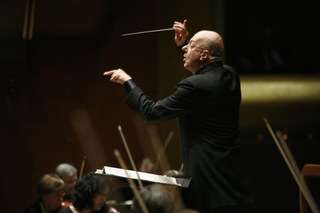|
Back
In the beginning New York
Avery Fisher Hall, Lincoln Centre
05/31/2009 -
Paul Ben-Haim: Fanfare to Israel (1950) – Symphony No. 2(1945) (U.S. Premiere)
Josef Tal: Symphony No. 2 (1960)
Ödön Partos: Ein Gev, Symphonic Fantasy (1952) (U.S. Premiere)
Mordecai Seter: Midnight Vigil, Op. 39a (1958) (U.S. Premiere)
American Symphony Orchestra, Leon Botstein (Musical Director and Conductor)

L. Botstein (© Steve J. Sherman)
The always meticulous Leon Botstein made it clear that the four composers represented yesterday afternoon certainly do not represent the State of Israel today. In fact, not a single one of this quartet was a sabra (a native-born Israeli), they arrived in Israel from three different countries. And, strangest of all, a knowing friend said that they are rarely played in Israel today.
In other words, with his usual prescience, and perhaps conscious knowledge that he is standing upon the shoes of American Symphony Orchestra founder, Leopold Stokowski, Mr. Botstein has chosen music which doesn’t seem to fit into any particular category
Much of the time, his chosen works are valuable as historical oddities. But the five pieces here were both unusual and rewarding. They were unusual first of all since little was distinctively “Israeli”. True, Paul Ben-Haim uses a hora for his finale (the dance sounding suspiciously like Aaron Copland’s hoedown), as well as a Persian song. The Hungarian Ödön Partos titled his symphonic fantasy with the name of a kibbutz, and the Russian composer Mordecai Seter has given specific mystical Hebraic scenes to his Midnight Vigil. But here too, this could have been a mystical Russian ritual.
Perhaps, as Mr. Botstein writes, the new Israeli government used artists as a matter of “national self-invention” for a nation which would be “by design, freed from all the baggage of history and convention.”
But, like Hollywood inviting journalists to the West Coast when “talkies” were invented, the Israeli Government had no idea what to expect. The results, in fact, reflected less on this “ideal nation” than the talents of the artists themselves.
Ödön Partos, for instance, was a product of Hungary until his 30’s, and his Ein Gev could well have been written by his teacher, Zoltán Kodály. A master of orchestration, he presented a work which could have been called Dances of Kibbutzniks, except that no Jewish themes, traditional or Israeli, poke their heads in. Instead, we have a set of whirling rhythms, giddy evocative scenes with melodic lines which sound more Magyar than Jewish.
That does make sense here, since the sudden major-minor changes are Arabic as well as Hungarian. Whatever the motivation, Mr. Partos’ work was diverting and highly accessible.
Most honest was Joseph Tal, who never considered music ‘Israeli” except for the fact that he happened to live there, and felt (oh shades of Wagner’s “world Jewry”!!) that this society was open to the world. An atonalist by choice, not particular inclination, his one-movement Second Symphony begins with a multi-layered set of repeated notes ŕ la Martinu, but then launches into a great crescendo of percussion and brass, where the tone-row is swiftly drowned in the good-natured dissonance.
The most pictorial work was Midnight Vigil by Mordecai Seter, with three scenes dealing with God, ghosts, the prophecy of the Land of Israel promised to Jacob. I wish I hadn’t read the detailed program notes, since I kept wishing to hear dead people, to get the word of the Lord. Instead, we had another engaging work which, with all its stories, never outlived its welcome.
The second half was devoted to the late Paul Ben-Haim, whose bittersweet Fanfare to Israel had started the concert. His Second Symphony, composed in 1945 and celebrating the end of the Second World War, was fairly lengthy but had almost an American Copland-like joy and exuberance. The scherzo, supposedly based on a Persian song, had an Andalusian feel, quite appropriate since Arab and Jewish music both were derived from Spain. But Ben-Haim’s delicacy of texture was highly professional. The long slow movement was compared to Mahler, but it was clearer, less ambiguous (and less profound). The finale, with an alteration from the opening of Beethoven’s C Minor Symphony, as well as a major-minor dizzying variations on the hora was pure delight.
That music, though, was written three years before Israel was declared a state. Who knows what their four composers would have written for today’s Israel? Perhaps Mr. Botstein will offer a concert of modern Israel, warts and all. In his own words, “the grim realities (of Israel) have made life more difficult than any of these composers might have anticipated.”
Harry Rolnick
|